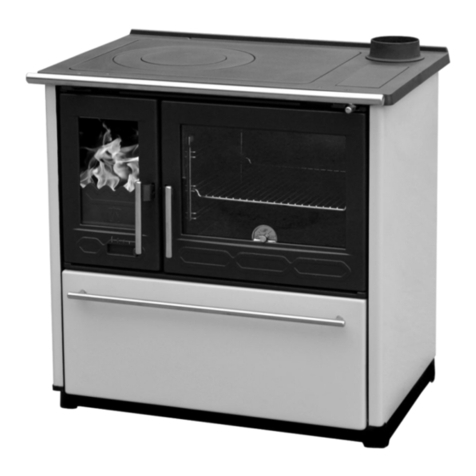
Instalacija termo proizvoda mora biti u skladu sa svim aktualnim normama i odredbama te u skladu sa
zakonima na snazi. Montažu, priključivanje na sustav, puštanje u rad i provjeru ispravnog rada moraju
biti izvršeni u skladu s pravilima struke, od strane ovlaštenog stručnog osoblja, uz potpuno poštivanje
normi na snazi, kako na državnoj tako i na regionalnoj i općinskoj razini zemlje u kojoj se uređaj
montira. Montažu smije vršiti samo ovlašteno osoblje koje izdaje kupcu ispunjenu i ovjerenu
potvrdu/radni nalog. Kupac je obavezan potvrdu/radni nalog čuvati te dati na uvid proizvođaču na
njegov zahtjev kao dokaz o izvršenoj instalaciji termo proizvoda od strane ovlaštene osobe.
Tvrtka Plamen d.o.o. ne smatra se odgovornom u slučaju kršenja gore navedenoga te ne
odgovara za eventualne nastale poteškoće u radu proizvoda i nastale troškove, ukoliko termo
proizvod nije instaliran od strane ovlaštene osobe.
Priključak kotla u sustav centralnog grijanja
Kotao se mora priključiti u sustav centralnog grijanja s otvorenom ekspanzivnom posudom kako u
slučaju pregrijanja vode ne bi došlo do povećanja tlaka u sustavu (slika 4).
Preporučujemo ugradnju 4-krake mješajuće slavine (miš ventila) koja omogućava reguliranje
temperature u polaznom vodu grijanja, a da je pri tome temperatura vode u kotlu dovoljno visoka (60 –
70°C) da se ne pojavljuje znojenje kotla i da ne dolazi do niskotemperaturne korozije. Na slici br. 5
prikazano je kako se kotao treba priključiti na instalaciju centralnog grijanja. Visinom H osigurati
dovoljan tlak u sistemu, da se osigura dobra cirkulacija kroz grijaća tijela. U sistemu se može (i
poželjno je) priključiti bojler. Dobro ga je priključiti tako da se osigura prirodna (odnosno gravitacijska)
cirkulacija koja je neovisna o pumpi. Bojler mora biti iznad nivoa peći, sa što manjim otporima za
cirkulaciju vode (što kraće cijevi s usponom prema bojleru).
Prije puštanja u pogon (prije prvog loženja) provjerite da li je sustav grijanja napunjen vodom i dobro
odzračen. Otvorite sve zaporne organe. Uključite optočnu crpku.
Uputa za uporabu
Prije prve potpale, vlažnom, pa suhom krpom prebrišite sve emajlirane plohe i ploču za kuhanje.
Isprobajte kako funkcionira regulator zraka i zaklopka dimovodnog kanala.
Dijelovi štednjaka su obojani bojom otpornom na visoku temperaturu. Kod prvog loženja ova boja
postupno stvrdnjava, pa može doći do dimljenja i karakterističnog mirisa. Zbog toga se pobrinite za
dobro provjetravanje prostorije.
Upozorenje! Ako prvo loženje nije umjereno može doći do oštećenja boje.
Zbog toga prilikom prvih loženja (najmanje 10 sati) ložite umjerenijom vatrom (punjenja trebaju biti
najviše pola preporučene količine goriva za nazivnu snagu).
Funkcioniranje štednjaka i kvaliteta izgaranja ovise o kvaliteti goriva i dimnjaka, dobrom podešavanju
jačine vatre, čistoći štednjaka, te pravilnom loženju. Štednjak je predviđen za loženje drvima, drvenim
briketima i briketima od smeđeg ugljena. Ložite samo suhim drvima. Kod loženja vlažnim drvima
nastaje čađa koja može uzrokovati začepljenje dimnjaka. Ne spaljujte nikakav otpad, posebice
plastiku. U mnogim otpadnim materijalima nalaze se škodljive tvari, koje su štetne za štednjak,
dimnjak i okoliš. Za postizanje nazivne snage preporučujemo, da dodate po dva komada drva ili briketa
svakih pola sata, a regulator zraka otvorite na poziciju koja Vam za jačinu vatre najbolje odgovara.
Pepeljaru treba redovito prazniti. Ne dopustite da pepeo dodiruje rost ložišta, jer bi u tom slučaju moglo
doći do njegovog oštećenja. Za potpalu vatre možete koristiti novinski papir i suha sitnija drva.
UPOZORENJE! Ne koristiti alkohol i benzin za potpaljivanje ili ponovno potpaljivanje.
Regulator zraka kod potpale treba biti maksimalno otvoren, a dugme poluge zaklopke, dimovodnog
kanala izvučemo prema van. Kod potpaljivanja vatre, kada su vanjske temperature više od 15°C,
može se dogoditi da u dimnjaku nema podtlaka (dimnjak slabo vuče). U tom slučaju pokušajte
potpaljivanjem dimnjaka ostvariti potreban podtlak. Za potpaljivanje vatre ne koristite špirit, benzin ili
nekakvo drugo slično gorivo. Ne držite nikakve zapaljive tekućine u blizini štednjaka.
Vrata ložišta moraju uvijek biti dobro zatvorena, osim kod dodavanja goriva. Štednjak treba redovito
čistiti i vršiti kontrolu od strane dimnjačara ili druge stručne osobe. Štednjak čistite s izuzetnom
opreznošću.
5




























